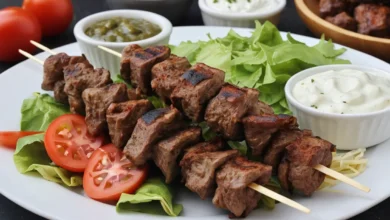Sweet and Salty Popcorn: The Ultimate Snack to Satisfy Your Cravings!

Popcorn is more than just a movie-time snack; it’s a versatile treat that can be enjoyed in countless ways. Among the many variations, sweet and salty popcorn stands out as a fan favorite, marrying the rich flavor of sweet ingredients with a savory touch. This delightful combination makes for a perfect snack for any occasion, whether you’re hosting a movie night, throwing a party, or simply indulging on your own. In this blog post, we’ll explore the irresistible charm of sweet and salty popcorn, how to make it at home, and creative twists you can try to elevate this classic treat. Get ready to pop some kernels and discover why this combination is a must-try!
1. Why Sweet and Salty Popcorn Is the Perfect Snack
Sweet and salty popcorn strikes a unique balance that appeals to a wide range of taste preferences. Here’s why it’s the perfect snack choice:
- Flavor Harmony: The combination of sweetness and saltiness creates a flavor profile that is both satisfying and addictive, keeping you coming back for more.
- Texture Contrast: The crunchy texture of popcorn pairs beautifully with the smoothness of the sweet toppings, creating a delightful mouthfeel.
- Versatile Enjoyment: Whether enjoyed at home, during movie nights, or as a party snack, sweet and salty popcorn can fit into any setting and cater to various audiences.
2. Health Benefits of Popcorn
While sweet and salty popcorn can be indulgent, it can also offer health benefits when made thoughtfully:
- Whole Grain Goodness: Popcorn is a whole grain, making it a good source of fiber, which aids in digestion and promotes fullness.
- Low in Calories: Air-popped popcorn is low in calories, making it a guilt-free snack option compared to many processed snacks, especially when you control the toppings.
- Antioxidant Properties: Popcorn contains polyphenols, which are antioxidants that may help reduce the risk of chronic diseases.
3. How to Make Sweet and Salty Popcorn at Home
Making sweet and salty popcorn at home is simple and requires just a few ingredients. Here’s a basic recipe to get you started:
Ingredients:
- 1/2 cup popcorn kernels
- 1/4 cup granulated sugar
- 1/4 cup unsalted butter
- 1 teaspoon sea salt (adjust to taste)
- Optional toppings: chocolate drizzle, caramel, or sprinkles
Instructions:
- Pop the Corn: In a large pot or popcorn maker, pop the kernels according to the manufacturer’s instructions. Transfer the popped popcorn to a large bowl.
- Prepare the Sweet Mixture: In a saucepan over medium heat, melt the butter. Once melted, add the sugar and stir continuously until the mixture starts to bubble. Allow it to simmer for about 2 minutes until slightly thickened.
- Combine Ingredients: Pour the sweet mixture over the popped popcorn and stir gently to coat all the popcorn evenly.
- Add Salt: Sprinkle sea salt over the popcorn while still warm, tossing to ensure even distribution.
- Optional Toppings: For added flair, drizzle melted chocolate or caramel over the popcorn and sprinkle with festive toppings like sprinkles or nuts.
- Serve and Enjoy: Allow the popcorn to cool slightly before serving. Store any leftovers in an airtight container to maintain freshness.
4. Creative Twists on Sweet and Salty Popcorn
The beauty of sweet and salty popcorn lies in its versatility. Here are some creative ideas to personalize your popcorn:
- Chocolate Drizzle: Add melted chocolate for a rich touch. Dark chocolate pairs wonderfully with the sweet and salty flavors.
- Nuts and Seeds: Toss in roasted nuts or seeds for added crunch and nutrition. Almonds, pecans, or pumpkin seeds are great options.
- Spices and Seasonings: Experiment with spices like cinnamon, cayenne, or paprika to give your popcorn a unique flavor twist.
- Seasonal Variations: Incorporate seasonal flavors like pumpkin spice in the fall or peppermint during the holidays for a festive touch.
- Savory Additions: Try adding a sprinkle of cheese or nutritional yeast for a savory contrast that complements the sweet elements.
5. Frequently Asked Questions About Sweet and Salty Popcorn
Can I make this popcorn ahead of time?
Yes! Sweet and salty popcorn can be made in advance and stored in an airtight container. However, it’s best enjoyed fresh for optimal crunchiness.
How can I make popcorn without a machine?
You can easily make popcorn on the stovetop using a pot with a lid. Just heat oil, add the kernels, and cover until they pop.
What is the best type of popcorn for this recipe?
Any popcorn kernel will work, but many prefer using high-quality, organic kernels for a better flavor and texture.
Can I use artificial sweeteners instead of sugar?
Yes! You can experiment with various sweeteners like honey, maple syrup, or sugar substitutes, but keep in mind that they may alter the taste and texture.
What should I do if my popcorn gets stale?
To refresh stale popcorn, you can place it in the oven at 250°F (120°C) for about 5 minutes. This helps to restore some of the crunchiness.
Conclusion
Sweet and salty popcorn is an irresistible treat that combines the best of both worlds in one crunchy bite. Whether you’re making it for a movie night, a party, or simply as a snack for yourself, the balance of flavors makes it a crowd-pleaser. With easy preparation and endless possibilities for customization, you can enjoy this delightful snack tailored to your tastes. So gather your ingredients, get popping, and enjoy the delightful crunch of sweet and salty popcorn today!





